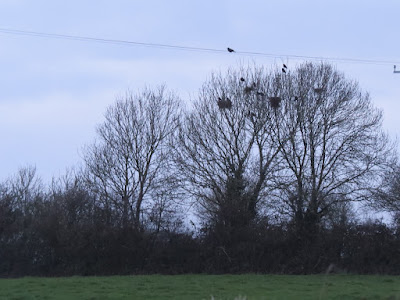Back at the end of January I wrote of the rook community at Wick St Lawrence, my local area. Back then the rooks were loafing about but aside from a couple of old nests which were being utilised, the bulk of the rookery activity had not begun. Last evening though, as sunsets are definitely occurring later, I stopped on my way home to check what is going on.
Plus, as I realised later, the blurred images due to the low light bring (in my view) an enhanced atmosphere to the images I took.
It was close to 6.30pm by the time I'd arrived home after my commute. The light remained but wasn't that great. However it was a preferred time for counting nests and birds as they were coming in to settle for the evening, allowing for a more accurate count of the population. At this time of the year we are at the cusp of massed winter roosts ending and socially cohesive communal rookeries developing. An interesting book from the 1930s by G. K. Yeates [2] first looked into this in depth, though some of his observations were discussed and revised soon after publication by one J. P. Burkitt in his short article on young rook at a rookery [1]. Yet it was Yeates who mentioned that mid March is a cusp time between winter roosts ending and the rookery roosts forming, which he estimated to be about a week before the first eggs lain. Certainly down here I'd suggest this happens two or 3 weeks earlier - late February?
All the nests are around the boundary of a large grass field. The first image above of three nests was especially welcome as this area had been heavily modified over the winter months. Luckily a couple of standing trees were left and three nests were in use. To my right, the trees by the field edge had six nests, though the exact number is hard to observe in that image. A quick count then, nine nests so far, meaning a minimum of 18 birds, assuming 2 birds to a nest. I didn't count the hangers on, more specifically, non-breeding, young, unpaired singletons or late nesting rook

Turning then to the main rookery area of trees hard by the road entering the village itself, a total of 12 nests were visible in the one tree. Remarkable that only two weeks ago not a single nest was here. Therefore a rough estimate, 24 rooks here plus the 18 from the other trees, 42 birds minimum. However there were a lot more birds loafing about in these trees and in other parts of the village. As I walked closer they fidgeted and squabbled, the noise was quite deafening. Below the trees on the lane was a matrix of sticks dropped, or fallen from the nursery structures above. I tried to count the birds as I walked and, while nearly impossible there were certainly more than 24 in this one spot.
Then as I walked under the nests the formerly agitated and fidgety birds who'd been watching me approach now arose from the branches en-masse in an almighty crescendo of noise the moment I stopped walking. That is quite usual for corvids, and other wildlife. They observe an approach and as long as there's nothing to worry about they'll hold their station but chatter away. However once movement stops immediately there's an eruption of birds calling loudly, both harsh caws of alarm and communication and the softer whistling contact calls rook make. Many of the birds wheeled just above the branches and then very soon began to return onto their nests, though a good number left the area completely, floating away like wood smoke in the blustery wind. I quickly withdrew and retraced my steps a little thus allowing the nesting birds to regain their former position as soon as possible.
That lift-off allowed me a rough calculation of individuals in this one assemblage and I would estimate around 40, so heading towards double the nesting pairs of 24. And in doing that rough calculation, shall we say an additional 40% non breeding birds in the community, then adding those here and the others in the trees I'd suggest somewhere over 60 birds in this small rookery encircling this large grass field. Not far away, less than a mile across the fields, is another rookery at Hewish of a similar size. Whether there is cross communication between these two rookeries I don't know but it wouldn't surprise me with these sociable crows.
Walking back to the car I noticed that twenty nine rook (counted from the image) were making use of the power lines crossing the field that the rook nests border. Most of these individuals were those who had flown off from the main rookery area, but not all, and probably these were a mixture of non-breeding individuals and maybe males waiting to return to the rookery. Moments after the image was taken they erupted again en-masse and headed back to their respective sub-groups in the trees, leaving me to take all I'd seen in and assess this wonderful end to the daily commute from work, counting rooks.
References
BURKITT, J. P - British Birds April 1935. Volume 28 Issue 11. NOTES ON THE ROOK:
With special reference to the proportion of young in flocks, and the change over from winter roosts to the rookery.
YEATES, G.K. The Life of the Rook. Philip Allan 1934






A super way to end the daily commute. I always love watching rookeries and all the activity there. It looks as though you have successful rookeries in that area. A fascinating post - thank you Andrew.
ReplyDeleteLets hope the rooks survive, as I type a reply to you we have a 50 mph wind - the same thing happened last year, March winds are not great for tall tree nesting birds.
ReplyDelete